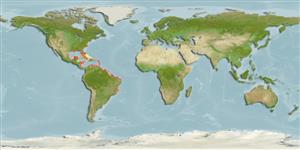Common names from other countries
Elasmobranchii (sharks and rays) >
Carcharhiniformes (Ground sharks) >
Carcharhinidae (Requiem sharks)
Etymology: Carcharhinus: karcharos (Gr.), sharp or jagged; rhinus, an ancient name for sharks, from rhine (Gr.), rasp, both words alluding to a shark's jagged, rasp-like skin. (See ETYFish); isodon: iso-, from isos (Gr.), equal; odon (Gr.), tooth, allusion not explained, perhaps referring to how its teeth are similar in shape and size in both jaws [authorship often attributed to Müller & Henle, who published Valenciennes’ description]. (See ETYFish).
Environment: milieu / climate zone / depth range / distribution range
Ecology
Marine; demersal; depth range 0 - 20 m (Ref. 106604). Subtropical; 42°N - 38°S, 100°W - 12°W (Ref. 55182)
Western Atlantic: North Carolina, USA to Cuba, the Gulf of Mexico, and southern Brazil to Uruguay (Ref. 58839). Occurrence in the eastern Atlantic, specifically in Senegal and Guinea-Bissau, have not been confirmed and may be based on Carcharhinus brevipinna (Ref. 244, 127434).
Length at first maturity / Size / Weight / Age
Maturity: Lm 129.0, range 119 - 139 cm
Max length : 200 cm TL male/unsexed; (Ref. 106604)
Commonly found close inshore. Forms large schools. Feeds on small bony fishes and cephalopods. Viviparous (with a yolk-sac placenta), 1 to 6 young per litter. Size at birth 51 to 64 cm. Presumably eaten fresh and dried salted.
Distinct pairing with embrace (Ref. 205). Viviparous, placental (Ref. 50449).
Compagno, L.J.V., 1984. FAO Species Catalogue. Vol. 4. Sharks of the world. An annotated and illustrated catalogue of shark species known to date. Part 2 - Carcharhiniformes. FAO Fish. Synop. 125(4/2):251-655. Rome: FAO. (Ref. 244)
IUCN Red List Status (Ref. 130435)
Threat to humans
Traumatogenic (Ref. 26340)
Human uses
Fisheries: minor commercial
More information
ReferencesAquacultureAquaculture profileStrainsGeneticsElectrophoresesHeritabilityDiseasesProcessingMass conversion
Tools
Special reports
Download XML
Internet sources
Estimates based on models
Preferred temperature (Ref.
115969): 22.9 - 28.1, mean 27 (based on 617 cells).
Phylogenetic diversity index (Ref.
82804): PD
50 = 0.5000 [Uniqueness, from 0.5 = low to 2.0 = high].
Bayesian length-weight: a=0.00479 (0.00221 - 0.01036), b=3.09 (2.92 - 3.26), in cm Total Length, based on LWR estimates for this Genus-body shape (Ref.
93245).
Trophic level (Ref.
69278): 4.2 ±0.7 se; based on diet studies.
Resilience (Ref.
120179): Very Low, minimum population doubling time more than 14 years (Fec=1).
Fishing Vulnerability (Ref.
59153): High vulnerability (60 of 100).
